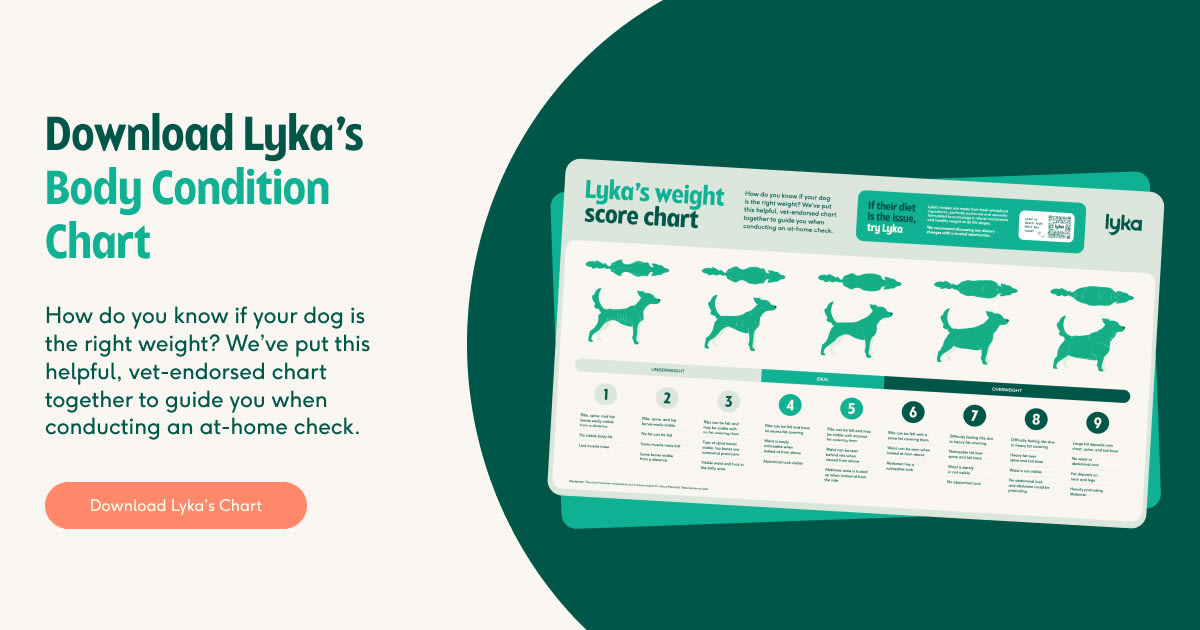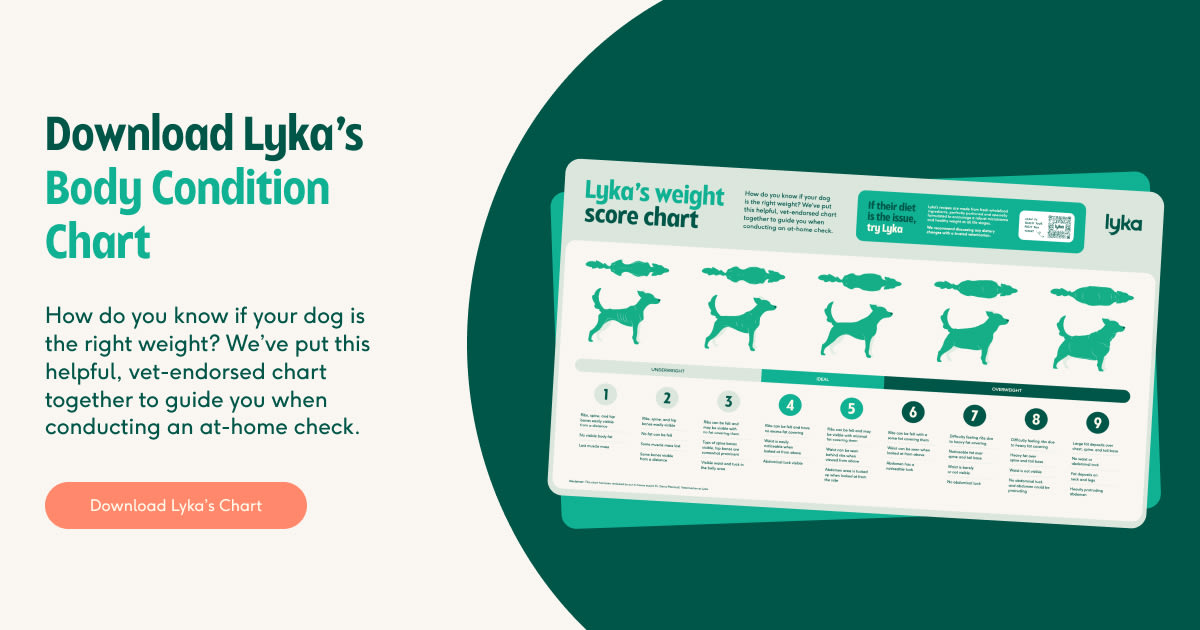Getting your pup’s weight perfect is one thing, but maintaining it can be just as tricky.
Too much weight can lead to diabetes, heart disease and a lower quality of life. On the other hand, underweight dogs are at risk of impaired growth and development.
The number of overweight dogs is on the rise in Australia with over 40% of dogs regarded as either overweight or obese — a leading concern amongst veterinary professionals.
It’s easy to equate well-fed with well-loved, and a chunky dog may seem like a cute and cuddly furball, but excessive weight gain can affect their quality of life and trigger other health concerns. An underweight pup can also lead to health risks.
Let’s explore the weighty issues facing dogs and their owners in Australia, and how a holistic approach that focuses on nutrition and vet-recommended strategies can help you manage your pup’s weight.
How to tell if your dog is the right weight
Maintaining your dog’s ideal weight supports the optimal function of their health from strong and supple joints to organ operation, to a strong immune system and everything in between!
How much your dog should weigh is based on their breed, age and activity level. Ask your vet to confirm your pup’s healthy weight range from these details.
A really easy way to visually check your dog’s weight at home is by inspecting their shape and comparing it to our vet-endorsed body condition score guide or by using our video.
The ideal body condition score is between 4-5. You should be able to feel their ribs under a small layer of fat. When you look at your dog from the side, there should be a clear abdominal tuck, and you should see a slight definition in their waistline when viewed from above.
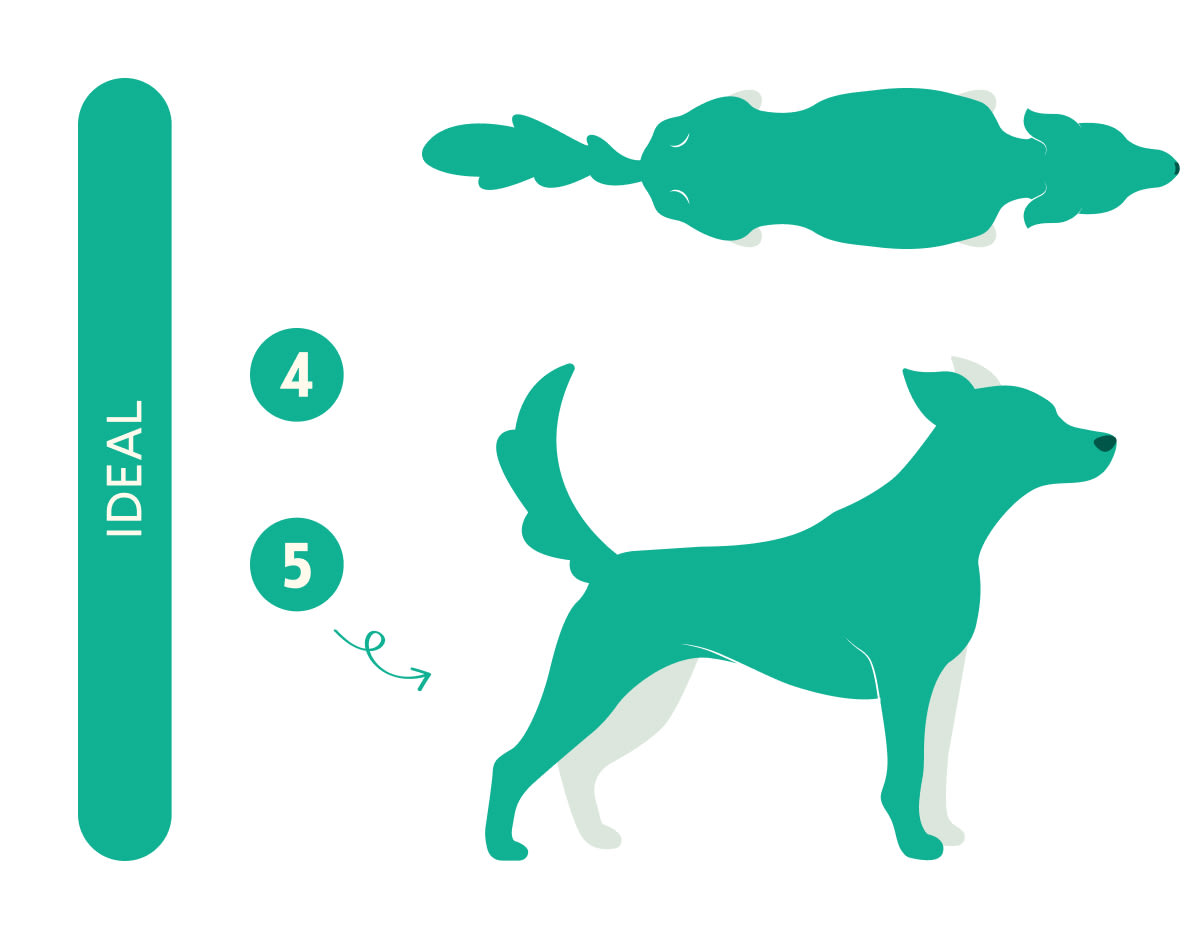
The health risks of excess weight
Being overweight isn’t just about a bit of extra padding — the health risks are significant.
Obesity increases the chance of many health problems in dogs, including diabetes, heart disease, chronic inflammation, joint problems like osteoarthritis, respiratory issues, reduced life expectancy and a lower quality of life.
You can tell if your dog is overweight if you have difficulty feeling their ribs due to heavy fat deposits, there isn’t a clear abdominal tuck and no noticeable waist. If your dog is obese, you may see fat deposits around their neck and legs, and they’ll likely have a protruding abdomen.
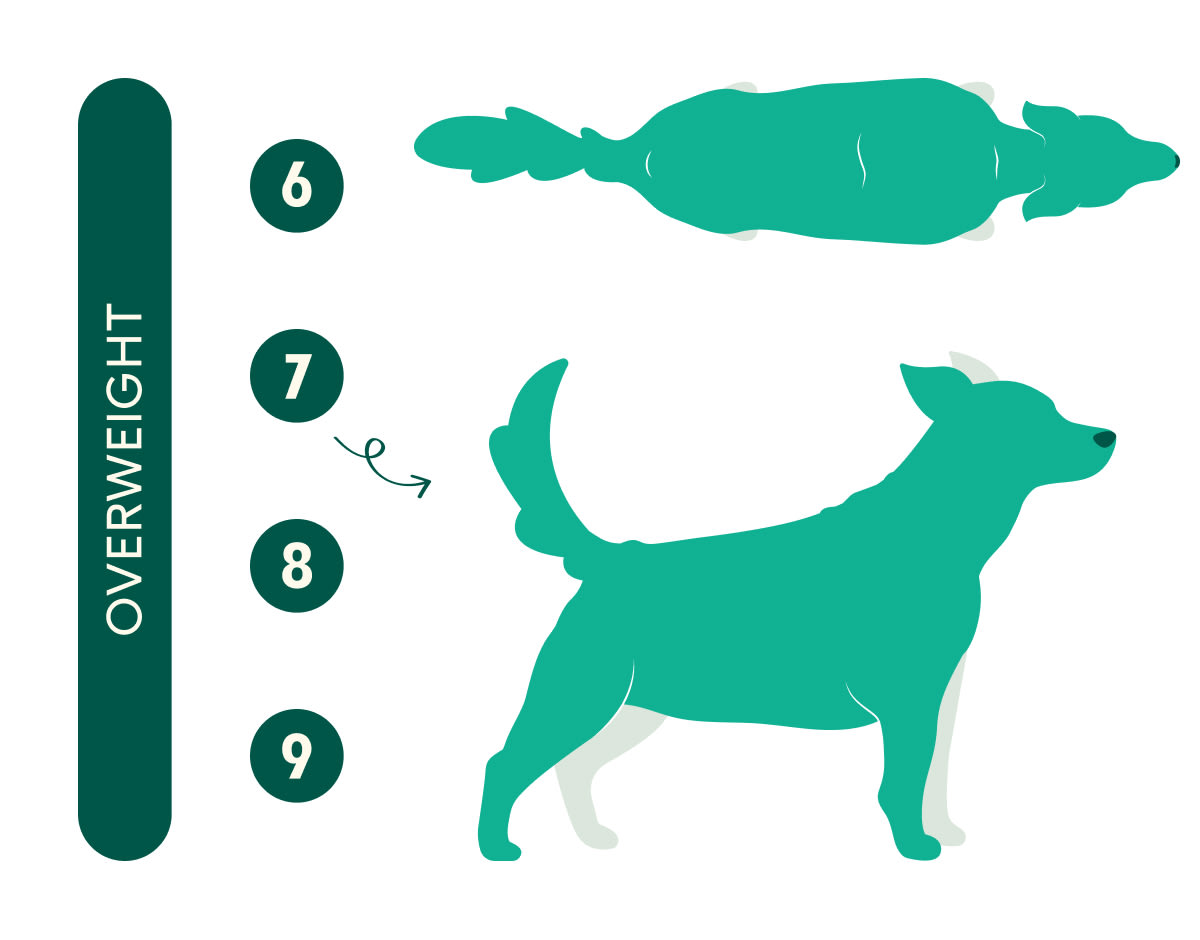
Some breeds of dogs are predisposed to obesity, including Cavaliers, Beagles, Dachshunds, Basset Hounds and Cocker Spaniels. Research has also identified a gene in Labradors that affects their ability to feel full and satisfied, making them prone to weight gain too.
5 common causes of weight gain and how to manage them
Weight gain and obesity are not just the result of too much food and too little exercise. The quality of your dog’s diet, as well as existing health conditions, can all contribute to the problem too.
Let’s put it into perspective: a 10kg dog that gains 1kg in weight is the equivalent of an average human gaining 5-7kg!
1. Diet and nutrition
Weight gain and obesity aren’t just as simple as too much food and too little exercise; it’s also connected to the variety and quality of food that a dog consumes.
Many commercial processed dog food brands use ingredients like legumes, wheat and beet pulp that have minimal nutritional value and can contribute to weight gain. They also often include high GI carbohydrates like rice and potatoes, which can lead to blood sugar spikes increasing the risk of weight gain, diabetes and chronic inflammation.
If your dog is overweight but always hungry, their diet might lack the nutrients they need, and they’re trying to address the deficit by eating more food.
The gut microbiome (the trillions of microorganisms living in your pup’s gut) plays a vital role in extracting calories and nutrients from food. The composition of your dog’s microbiome is directly related to their diet, and studies have shown that obese dogs have a different microbiota to lean dogs.
Other research explores how an imbalanced microbiome (dysbiosis) impacts metabolism, effective energy extraction, and the key neurotransmitters that signal fullness, contributing to weight gain.
Next steps: A high protein, low carbohydrate diet made from various wholefood ingredients and rich in prebiotic fibre supports a diverse and balanced microbiome for peak health and wellbeing.
Choose healthy dog food that contains low GI carbohydrates, like fresh vegetables, to nourish your pup and release energy slowly. It will also keep them feeling fuller for longer, minimising cravings for food or snacks in between meals.
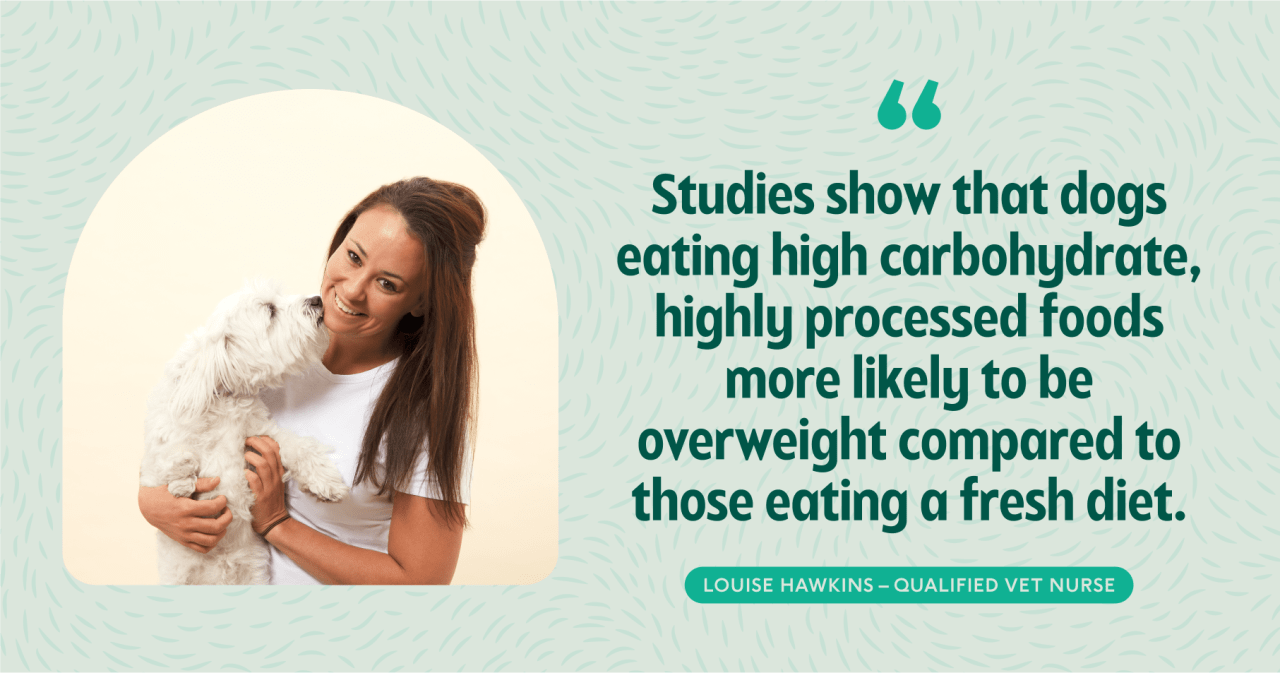
2. Portion control
Like humans, dogs need a certain number of calories each day to maintain optimal health and weight, depending on their age, breed and activity levels. Free-feeding your pup without calculating portion sizes can be an easy route to weight gain
Next steps: If your pup is overweight, your vet might suggest a change to their diet and portion sizes with a controlled deficit in calories to help them return to their healthy dog weight.
Lyka meals are delivered in customised portions based on your dog’s profile to make calorie control easy. We can also adjust the quantity to aid your pup’s weight loss journey.
3. Snacks and treats
Humans aren’t the only ones tempted by a sneaky snack between meals; dogs can also chow down on one too many treats. We know it’s easy to throw them a quick tidbit as a reward, but they soon add up.
Like your dog’s meals, the quality of treats can also impact their health with many containing fillers, sugar and salt. They can be the equivalent of junk food — very tasty but not very nutritious.
Next steps: When calculating how many treats your dog should get each day, the rule of thumb is no more than 10% of their daily recommended calorie intake.
Dogs require approximately 60 calories for every 1kg of their ideal body weight. A 10kg dog should only be given 60 calories worth of treats. To give you an idea of what this looks like:
One inch cube of cheddar cheese = 68 calories
One pig’s ear = 125-200 calories
Cooked chicken breast (approx ½) = 142 calories
When buying treats, choose single-protein products that don’t contain added ingredients, artificial flavours or preservatives. Protein also suppresses appetite by reducing the hunger hormone. Lyka’s range of air-dried, healthy single-protein treats are tail-waggingly tasty and ideal for pups of all ages.
Vegetables like carrots, broccoli and celery are also great treats to give your dog and make a nutritious alternative to meat-based products.
4. Exercise
Regular exercise is vital for every dog to keep their body fit and their mind sharp.
Support your dog’s weight management by creating a balance between calorie intake through diet and calorie expenditure through metabolism and exercise.
But not all exercise is equal, and not all dogs have the same requirements. High-energy working breeds, like Australian Shepherds, require up to two hours of vigorous exercise per day, yet brachycephalic breeds, like Pugs, only need up to 45 minutes of low-intensity exercise.
If you’re unsure what type and length of exercise your dog needs, have a quick chat with your vet.
Next steps: Establish a regular exercise routine with your pup according to your dog’s individual needs — it’s a great opportunity to bond with your dog through play or exploration. Bear in mind that their energy levels can change with the seasons but their need for exercise isn’t weather dependent.
5. Health conditions
Diseases and illnesses like Cushing’s disease, insulin resistance, hormonal imbalances, and some medications can impact your dog’s digestion or metabolism, affecting their weight.
If your dog is overweight but doesn’t eat much it could indicate hypothyroidism, which slows the metabolism down.
Next steps: If you’re worried about your dog’s size and shape as a result of ongoing illness, your veterinarian can advise you, based on their individual needs. This may include a change to their diet or alternative medication.
The health risks of being underweight
Underweight dogs are often malnourished, leading to further health concerns, including:
Nutritional deficiencies
Reduced immune function
Impaired growth and development
Reproductive difficulties
Underweight dogs have visible ribs, spine and hip bones with little muscle mass and no identifiable fat deposits.
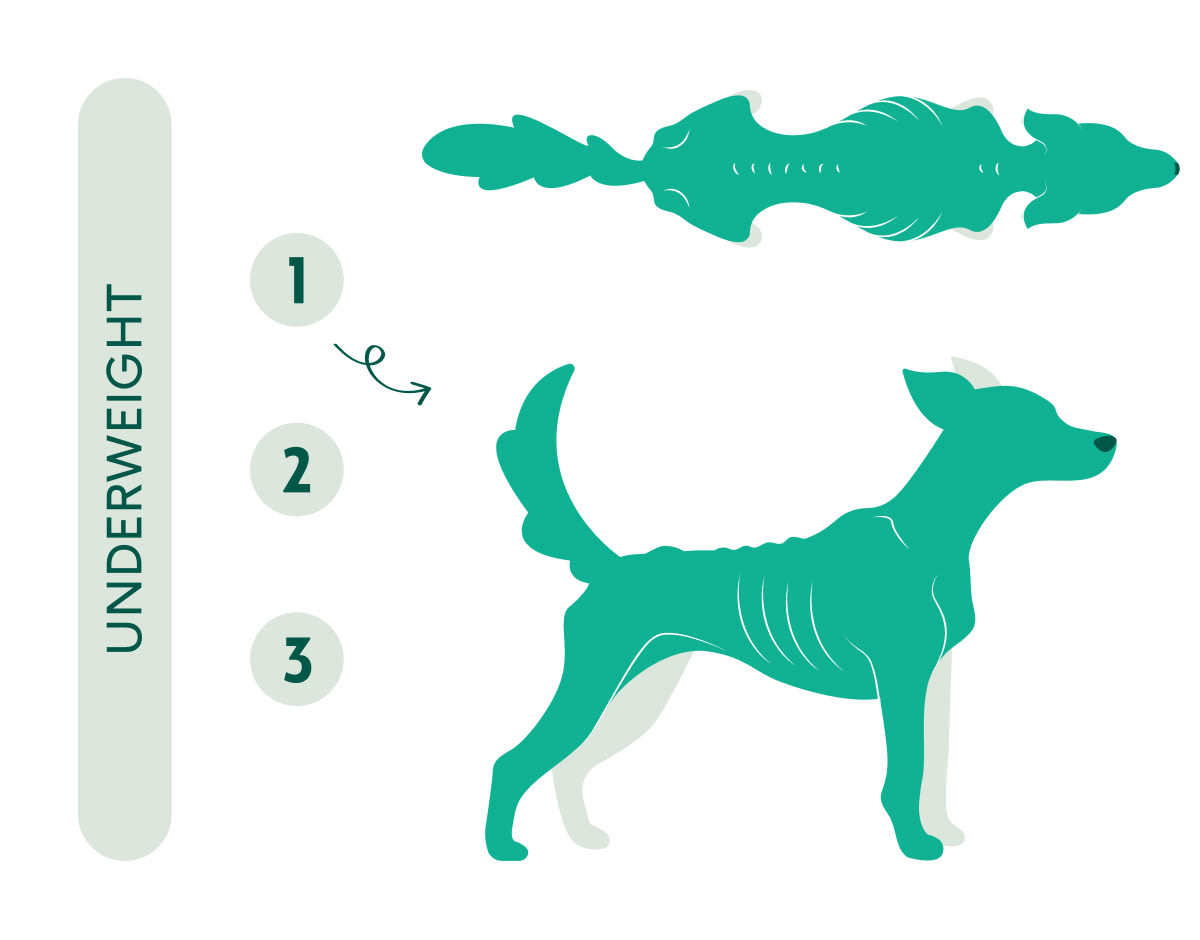
Some breeds have naturally lean body shapes that make them appear underweight, such as sight hounds like Whippets and Greyhounds. While Border Collies and Basenjis have faster metabolisms than other dogs, which can make them prone to being underweight. These breeds may require regular weight checks to keep within the healthy range.
8 common underweight causes and how to manage them
1. Diet and nutrition
Poor quality dog food is often formulated with cheap fillers and low-calorie ingredients, which lack the essential nutrients and energy necessary for a dog’s daily needs, leading to malnutrition and subsequent weight loss.
Insufficient protein in a dog’s diet leads to decreased muscle mass and energy levels, causing weight loss.
Next steps: Check that your dog’s diet is complete and balanced so they’re not missing out on any nutrients that may be contributing to their weight loss. This is especially important if they eat home-cooked meals or a raw diet.
If your dog is underweight, the portion they receive each day may be too small for their daily needs, especially if they’re an active or working dog. Speak to your vet about the quantity and quality of their diet, if you’re not sure.
Lyka’s complete and balanced meals are customised into portions that meet your dog’s daily nutritional and calorie needs. We can also work with you to find the ideal serving size to encourage your pup’s gradual and healthy weight gain.
2. Poor digestion or malabsorption
If your dog is eating their food as normal but is still losing weight, they may have an underlying health condition affecting their ability to digest and absorb nutrients, or their diet could be the cause.
Exocrine pancreatic insufficiency (EPI) is the body’s inability to produce enzymes to digest proteins, fats and carbohydrates. This often results in weight loss and, ironically, an increase in appetite as the dog tries to compensate for their digestive difficulties and malabsorption of vital nutrients.
Small intestine bacterial overgrowth (SIBO) affects the surface of the intestines that absorb nutrients, leading to malabsorption, weight loss and chronic diarrhoea.
Low-quality ingredients, artificial additives, preservatives and excessive fibre content can trigger digestive issues including diarrhoea and bloating that can also affect your dog’s absorption of nutrients leading to weight loss.
Next steps: Look for highly digestible diets containing quality ingredients like human-grade protein to maximise your dog’s nutrient absorption.
If you’re concerned about your dog’s health, speak to your vet. They can investigate, identify the underlying cause of your pup’s weight loss and create a treatment plan.
3. Oral health
Loss of appetite (inappetence) may be caused by a dental issue like a painful tooth, swollen gums or even an abscess, making it difficult to eat.
Next steps: If your dog has lost their appetite and is struggling to eat their food, make an appointment with your vet for a thorough oral health examination.
4. Age
Puppies are constantly curious and playful, always on the move. Even the process of training a puppy will use a significant amount of energy — both yours and your new pup’s!
Puppies need more calories to support their physical and mental development. But if your puppy is underweight and missing growth milestones, they might not be receiving enough calories to keep up with demand.
As dogs reach their senior years they can lose weight as a result of a change in metabolism, appetite, digestive function or age-related illnesses.
Next steps: If you’ve noticed weight loss in your puppy or senior dog, speak to your vet to find out if any underlying health issues might be affecting them. They can also advise you on the best diet and nutrition that’s appropriate for their age.
Lyka has tailored diets customised to your puppy’s breed, weight, age, and activity level that updates as they grow, so you never have to worry about them getting the nutrients they need to grow and thrive. Our biologically-appropriate recipes contain targeted nutrients to support each growth stage of puppyhood.
5. Medical conditions
Weight loss can be caused by diseases that affect the metabolism or curb your dog’s appetite. These may include diabetes, hyperthyroidism, heart disease, cancer, inflammatory bowel disorder or infections in the gastrointestinal tract.
Next steps: If you’re concerned about your dog’s health, seek advice from your vet as soon as possible.
6. Parasites
Parasites such as Roundworms can be a common cause of weight loss because they live in the dog’s intestines and feast on their nutrients. These worms can multiply quickly if left untreated and can create the appearance of a pot belly.
Next steps: If your vet confirms that your dog has picked up a parasite, they can provide a quality dewormer that should clear the problem up. As dogs can pick up parasites easily from their environment and other dogs, prevention through regular worming tablets is recommended.
7. Stress or anxiety
Both humans and dogs can lose their appetite when they feel stressed because their body is in a heightened state of fight or flight responsiveness.
Next steps: If your dog struggles to relax and seems anxious for long periods, their focus is probably on their immediate surroundings, not their mealtimes. Help them learn how to relax through training and try to find quiet, safe spots that they can retreat to, away from any stimulus that might be causing stress.
8. Activity
If your underweight dog is very energetic or a working dog, they may be burning off more calories than they’re consuming.
Next steps: If your pup enjoys a complete and balanced diet, consider increasing their portion sizes under the guidance of your veterinarian. Monitor their weight and their body condition until they reach the ideal size for their breed and age.
The holistic way to balance the scales
Lyka’s complete and balanced meals made from fresh, wholefood ingredients help support a healthy weight at all life stages.
Each recipe is designed for effective nutrient absorption, and is perfectly portioned based on your dog’s unique profile so they get the right calories and nutrients for their daily needs.


